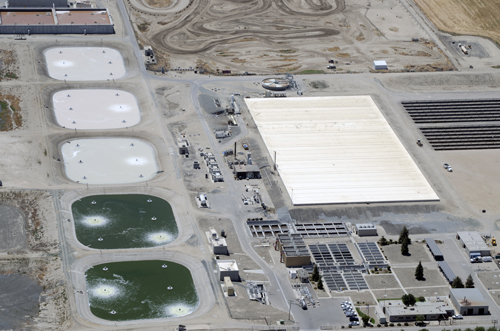Leading by Example: City of Tulare puts waste-to-energy into practice
 Located in California’s renowned San Joaquin Valley, the city of Tulare is bordered by coastal mountains and three beautiful national parks (Yosemite, Kings Canyon, and Sequoia). The city’s long-standing mission statement is: “To promote a quality of life, making Tulare the most desirable community in which to live, learn, play, work, worship, and prosper.”
Located in California’s renowned San Joaquin Valley, the city of Tulare is bordered by coastal mountains and three beautiful national parks (Yosemite, Kings Canyon, and Sequoia). The city’s long-standing mission statement is: “To promote a quality of life, making Tulare the most desirable community in which to live, learn, play, work, worship, and prosper.”
What’s not mentioned in this statement, however, is the city’s ongoing desire and commitment to a more sustainable way of life. This fact is worth noting considering that Tulare just celebrated 25 years of dedication to producing energy from the industrial wastewater being sent to its treatment plant. This is an impressive achievement considering most regions have only begun to consider how alternative forms of energy can fit into their community’s power plans.
Making use of industry
As California’s top agricultural-producing region, the San Joaquin Valley is sometimes referred to as “the nation's salad bowl” because of the great array of fruits and vegetables grown in its fertile soil. Along with its rich agriculture, Tulare is known for its dairy industry and is home to six large-scale dairy producers.
Like many municipalities, the city faces challenges to meet industrial wastewater treatment requirements at a reasonable cost, while maintaining harmonious relationships with the surrounding community. To this end, the Tulare Board of Public Utilities (BPU) and city council have been innovative in selecting technologies that leverage its unique environment, and that provide maximum value to the Golden State’s industries and residents.
From wastewater to biogas
Conservation and energy efficiency are extremely important to Tulare and its local industries—and have been for many years. Back in 1989, the city selected anaerobic digestion technology as an efficient means of treating local wastewater to meet state regulations. The dairy facilities in Tulare—including Nestlé-Dreyer’s, Saputo Cheese, Kraft USA, and Land O’Lakes—produce large volumes of high-strength industrial wastewater that’s sent to the city for treatment.
Anaerobic digestion of industrial wastewater causes naturally occurring micro-organisms to break down organic materials and produce biogas, which is a mixture of methane and carbon dioxide. The technology has allowed Tulare to comply with strict discharge limits. Moreover, it also offers an ability to convert waste to energy. As part of the anaerobic digestion process, the biogas produced can be combusted to produce renewable electricity, or further processed into compressed natural gas (CNG) fuel. But first, biogas must be safely and reliably captured.
Beyond power production
Since biogas can be used as an alternative fuel to generate green energy, the city of Tulare had been searching for a means to collect biogas from the digester. Such a system would not only help with the city’s bottom line by providing attractive energy savings, but it would also contribute to environmental protection efforts by reducing harmful greenhouse gas emissions. Additionally, the right cover would help control foul odors from the Tulare Waste Pollution Control Facility, strengthening the city’s reputation within the community.
As a result of these considerations, the solution turned out to be a floating gas collection cover. Typically used for lagoon or large-tank applications, gas collection covers are ideal for applications requiring complete gas containment and gas collection.
The gas collection cover was custom-designed, manufactured, and installed over the complete four-acre surface of the city’s digester at the facility. The cover is engineered to be gastight, so that it contains all the biogas generated by the digester, thereby eliminating odors. It is also chemical- and UV-resistant, a necessity in the region to properly withstand the tough environment of the digester and the hot California sun.
Beyond providing an energy alternative, the city of Tulare’s gas collection cover is strong and stable, allowing personnel to safely walk across the digester for easy operation and maintenance. Even the rainwater that pools on the cover’s surface is collected and drained.
Recognizing sustainability
Tulare certainly leads by example. The city was recently recognized with the Green California Leadership Award for its energy efficiency strategies, which include the waste-to-energy initiative designed to reduce the generation of overall greenhouse gases. This award offers a unique and rare recognition of public sector accomplishments in sustainability. According to the Green California website: “All nominated projects must be publicly financed and executed, and must have provided a measurable benefit to the natural or human environment” (www.green-technology.org).
Today, the gas collection cover installed at the Tulare Waste Pollution Control Facility collects up to 600,000 ft³ (16,990 m³) of biogas per day from the digester. This is enough biogas to generate a significant portion of the plant’s required power, making the facility less dependent on the area’s electricity grid, while helping to offset Southern California Edison energy costs.
Darin Evans is the VP of GTI Product Management.
Geomembrane Technologies Inc. (GTI)
www.gticovers.com
Author: Darin Evans
Volume: September/October 2014










